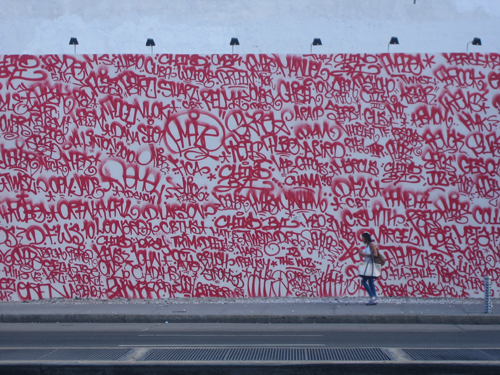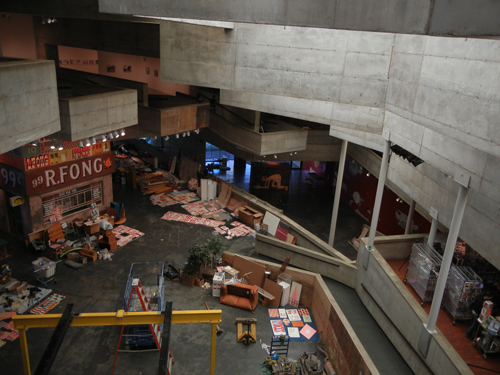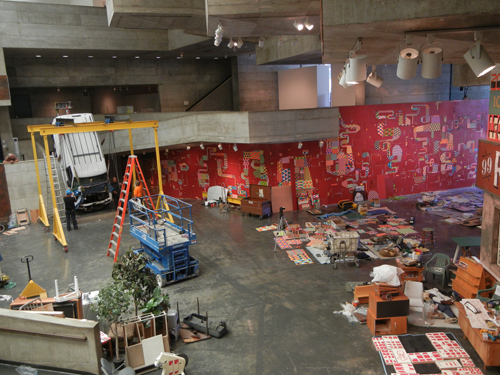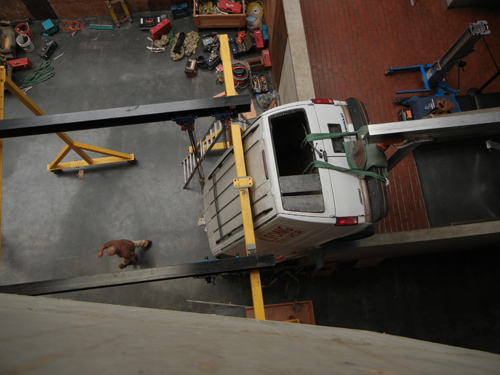I'd been having a conversation over a colleague's cubicle wall when another programmer in our department came over to say he'd been watching Endeavor-sightings scroll by on Twitter. He said it looked like the shuttle would be flying over Berkeley in five or ten minutes. So a few of us headed for the stairwell, bouncing ideas around for which nearby open space might be best for catching sight of the farewell flight.
We figured the pilots would fly by sites along the East Bay hills where amateur astronomers gather to watch the skies: the Chabot Space and Science Center, a few miles south of the Oakland/Berkeley border; the Lawrence Hall of Science directly uphill from the university. And we knew the flight was booked to pass by the Golden Gate and Bay Bridges. So there was little doubt, given the geography, that the shuttle would pass over at least some parts of the campus.
As it did. Boy, did it...
On the corner nearest to our building, a woman said her husband had seen the shuttle pass over Walnut Creek about ten minutes before. That meant the Endeavor would fly over the campus any minute, so we decided to just wait where we stood, at the intersection of Hearst Avenue and Oxford Street.
We didn't wait long. As if out of nowhere, flying so low it seemed to graze the tops of the trees, the shuttle, its Boeing-made steed, and a fighter-jet escort came looming over Oxford Street and roared by us, almost directly overhead.
The photo posted above -- thanks to Flickrnaut Doug Letterman -- was taken in downtown Berkeley near the corner of Shattuck Avenue and Haste Street, a little more than a half-mile from where (and so only a few seconds before) the farewell flight passed over our intersection. I didn't have a camera handy, but Mr. Letterman's snap gives a pretty good sense of how low the Endeavor was flying. We were standing more directly underneath the flight path: as it passed overhead we had a curb's-eye view of the 747's underbelly.
Back up in our office ten or fifteen minutes later we caught a second glimpse from our windows as the flight took a run north along Berkeley's bayshore marina, having circled over the Golden Gate Bridge, the city of San Francisco (where a colleague's wife had a fantastic view from their third-floor deck in the Mission), and the Bay Bridge.
Here's a video taken by a staff member at UC Berkeley's Public Affairs Office. She appears to be standing just off the southwest corner of the campus, about halfway between where the photograph above was snapped, and where I stood. The video gives a better sense of the angle I had on the flyover a few blocks further north.
Awesome as the sight of the shuttle was on Friday, I've certainly asked my share of skeptical questions about the space program over time. Is NASA worth the millions invested in its work? Is the agency's real mission the militarization of space? Would we do better to grapple with what's broken here on Earth than to focus on other planets and stars?
In the Endeavor's particular case: Does Los Angeles really have to cut down 400 trees to move the shuttle overland to its berth at the California Science Center?
These are all valid questions. But on Friday morning, as the product of some of the most advanced and complex engineering ever achieved by humankind flew overhead, almost near enough to touch, I have to admit those questions were relegated to background noise for this gape-mouthed spectator.
Perhaps Mike Kepka got it right about our susceptibility to technology, in his SF Chronicle piece yesterday, Screen Time addicts. The article muses about smartphone zombies -- those people who stare at their screens in public, in utter thrall, ignoring the world around them. Here's an excerpt:
[...] Every sidewalk, every street corner, every bus stop now has smartphone dropouts. Heads dip at a 45-degree angle as they lock into the tiny screens, oblivious to their surroundings, the community tuned out, their best friends in the palms of their hands.
"If I'm outside, I'm on the phone looking down," Bob Glasman said as he checked a message in Hallidie Plaza while on break from selling shoes in the mall. "San Francisco is getting less friendly — that's what it's about. I used to walk and say hello to everyone. … Keeping my head down is a better option."
"I became numb to it. It just became the norm," said Gerard Taguiam, 31, moments after checking his Instagram for the 50th time that day. "We are so detached now. It's the only way my friends and family can keep up with me. We are so busy and we don't really have time to interact. It's the only way that we can stay connected."
"Technology is a part of our evolution as a species. We are sort of addicted to this process," said Dedrick Reid, 34, an independent systems designer in San Francisco who was focused on his iPhone while riding a Muni bus down Market Street.
"It's an unfortunate consequence of being excited about technology," Taguiam said. "It's also an unfortunate convergence of lifestyle, communications, entertainment and information. All this stuff is sitting on your device, so you're locked in. It becomes your world."
I didn't feel the same watching the last of the space shuttles fly off into the sunny south of California as I do during Fleet Week each year, when the Blue Angels thunder over downtown San Francisco. Military might gives me no warm-and-fuzzies.
But as the Endeavor flew over my alma mater, that olde tyme inner-geek was firing on all cylinders.
Related posts on One Finger Typing:
Moon landing: through a ten-year-old's eyes on 20 July 1969
Transit
April showers brought May flowers
Thanks to Doug Letterman for the image of the Endeavor over downtown Berkeley, on the morning 21 Sept 2012.












